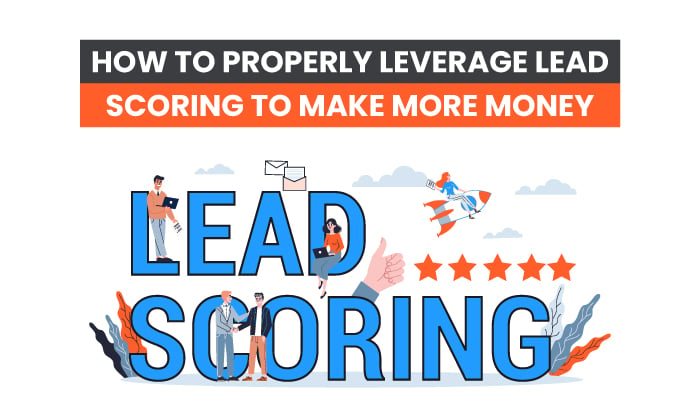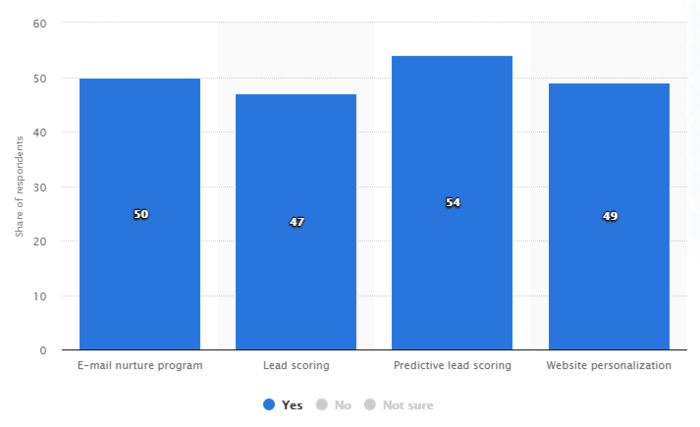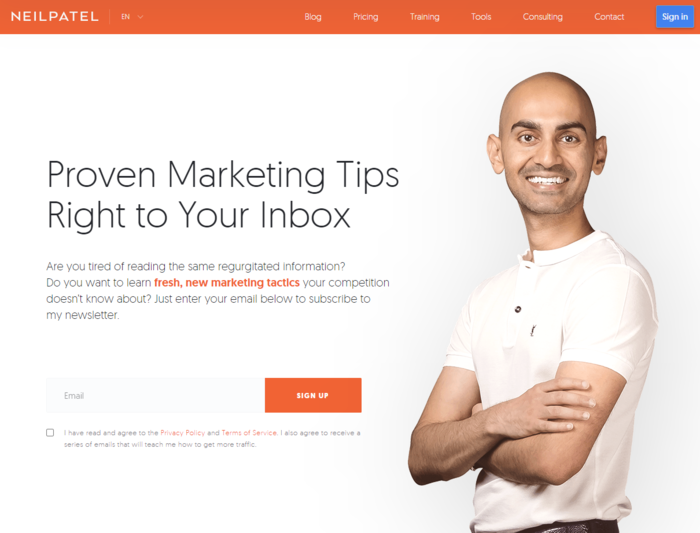
The biggest brands in the world understand one simple truth: Not all leads are created equal.
Having the ability to find and convert high-quality leads is what keeps these brands successful. The best and brightest aren’t just focused on volume; they want to sell to the best possible prospects.
Today, we’re taking a page out of their book and focusing on the quality of leads. Whether you’re running a corporate startup marketing campaign or moving your local business into the digital age, you can’t afford to waste time and money on weak leads.
That’s why I’m going to introduce you to the world of lead scoring and help you understand what it takes to build an effective lead scoring model for your business.
What is Lead Scoring?
Before we dive deep into the metrics and methods you’ll use, let’s establish a baseline definition of lead scoring.
At its core, lead scoring functions is a tool for marketers looking to qualify their leads accurately. Lead scores are used to determine how likely a particular prospect is to convert based on specific characteristics.
Why do lead scores matter? As I mentioned earlier, not all leads are the same. Forty-seven percent of B2B marketers found lead scoring to be effective, with 54 percent pointing to predictive lead scoring effectiveness.

The chances of converting a cold call lead are drastically lower than those of a referral lead. Using lead scoring, you’re able to arm yourself with a system that tracks and calculates lead scores.
What Are the Pros of Using Lead Scoring?
Now that you understand what lead scoring is, let’s talk about why it’s beneficial to your bottom line.
Less Wasted Time and Money
A business that uses lead scoring learns how to allocate its resources efficiently. Spending thousands of dollars and hundreds of hours on a marketing campaign that delivers average returns and unclear data is not something most businesses can afford.
Accurate Buyer Personas
Lead scoring is especially useful for businesses selling high-value products and services. The more complex the decision, the longer your average conversion time from prospect to customer. By evaluating their behavior throughout the buyer’s journey, you’re able to identify the prospects most likely to convert.
Using that information, you can update your buyer personas and start crafting marketing campaigns focusing on prospects typically converted.
Strengthen Your Prospect Relationships
The deeper your understanding of a buyer’s journey, the more likely it is that you’ll be able to point them toward a conversion.
Imagine for a second that Business XYZ already has a fantastic click-through-rate using paid ads. Ten percent of impressions lead to a click. That’s great news!
There’s just one problem: Its conversion rate is terrible. For whatever reason, it can’t consistently attract buyers.
By using lead scoring, Business XYZ can determine what pages and experiences scare away potential customers. More importantly, it’s able to change and improve those experiences, strengthening its marketing funnel’s weaker elements.
This behavior doesn’t just earn more conversions. It also helps prospects feel more secure about their purchase and develops the business’ reputation as a customer support specialist. It becomes known as a business that takes care of its customers at every stage.
By developing a deeper understanding of your customers using lead scoring, you’re able to create unparalleled user experiences.
Simplify the Lead Evaluation Process
Manually, the ability to optimize your marketing and sales efforts with lead scoring identifies and converts the right prospects much easier.
Of course, if you’re looking at automated solutions, you’ll be able to qualify leads using predetermined guidelines quickly.
Metrics for Scoring Your Leads
The actual process of scoring your leads can be a bit intimidating, even if you’re an experienced marketer. To keep this guide accessible, I’ll focus on four key metric classifications to rely on.
Demographics
One of the most basic marketing concepts is the buyer persona, a representation of your ideal customer. To build this buyer persona and begin determining the appropriate metrics for your lead scoring efforts, you need to begin with their demographic.
Personal information like age is a common starting point, but you’ll likely want to focus on professional information and capacity too.
Ask these questions:
- What characteristics does your ideal customer have?
- How do these characteristics empower them to make a purchase?
- How can you create experiences that appeal to these customers?
If you’re selling a high-value B2B product or service, it’s unlikely that students are your ideal target audience. However, if your lead identifies as an industry professional, they’re much more likely to convert.
Lead scoring helps you organize this information, test your theories and assumptions, and identify the factors contributing to a conversion.
Point of Origin
Break down the buyer’s journey and start with their first point of contact. If you have a sales background, this process should feel familiar. When determining which metrics to use, identify the lead’s point of origin.
Look to see where your leads are generated. Are they on your site because of organic search, or did they click on an ad? Did they visit your site on mobile or desktop?
As you track the sources of these leads, you’ll find that certain lead channels produce leads that are more likely to convert than others. You’ll also notice certain combinations have unique conversion rates.
For example, a lead that reached your landing page through a post on social media should have a lower score than an organic search lead that’s visited the pricing section three times.
Different points of origin are given different scores, making it easy to determine both the marketing channel’s overall value and the lead’s individual quality.
Focusing on the source also keeps your sales team informed. By preparing your sales team with contextual information on the prospect, they can accurately determine the prospect’s knowledge of the business and product or service.
Behavior
A prospect’s point of origin is an important building block when determining their conversion potential, but it’s just the tip of the iceberg. Analyzing prospect behavior and actions can help you identify the paths that lead to a genuine sale.
Most lead scoring systems use a points system, attributing specific values to particular behaviors. The beauty of this approach is that you’re able to stress-test your assumptions about your business and determine how impactful a particular behavior is.
For reference, an action is a decision a particular lead makes once they’ve started interacting with your business. These can include:
- visiting a landing page
- subscribing to a newsletter
- requesting a price quote
- signing up for a product demo
- reading blog articles
- asking questions via online chat
If email signup is a massive predictor of conversion, give that a high score and you’re able to focus all of your attention and marketing efforts on prospects that sign up for your newsletter.

If you’re right, your conversion rate rises, and you can continue to optimize. If you’re wrong, your conversion rate doesn’t rise to meet your goals, you take a closer look at your data and restructure your score allocation.
Either way, your business walks away with a win.
Engagement
Engagement and actions are two separate categories. Actions track the individual decisions prospects make, like reading a blog post or signing up for a newsletter. Engagement tracks the timing of those decisions, identifying how much time they spend on a blog post or email.
A general rule of thumb is that the longer a prospect spends consuming your content and interacting with your business, the more likely they are to make a purchase.
Of course, you’ll likely want to set a maximum achievable range to avoid ruining your data. For example, if a prospect leaves their computer on overnight, that could harm your lead scoring efforts.
Methods for Scoring Your Leads
The methodology for scoring your leads can be broken down into two sections: lead scoring strategy and common practices.
Lead Scoring Strategy
Establishing a clear, baseline process for lead scoring can help your business from a mechanical perspective.
Determine Metrics to Score
Let’s start with the baseline process. You’ll begin by determining the metrics and variables you want to score. While it’s easy to focus on highly converting metrics, you also need to determine which metrics convert poorly. This can help you better understand your market and customers.
Calculate Values
Next, calculate both the value of the metrics and the value of your leads. There are two common approaches to calculating the value of a metric:
- Conversion rate: This is simple enough to calculate. Divide the number of conversions by the number of leads attained and multiple by 100.
- Lead yield: This approach is a bit different. It’s a measurement of the total revenue made from conversions. Take your revenue and divide it by the number of leads generated. This gives you the average value of a particular conversion.
To be clear, there’s no right answer. The method you use depends entirely on your overall business goals and pricing structure.
Making calculations based on conversion rate might be a great idea for B2B SaaS businesses with long lifetime-value customers. B2C businesses and companies that offer fixed-price products are more likely to find lead yield useful. After all, the higher the value of an individual sale, the more valuable that lead was.
Compare Values
Now you can compare the value of a particular group of conversions to the average value of all your conversions. This lets you qualify the performance of a particular metric and determine its importance.
Assign Scores
Based on the performance of a particular metric in relation to the average customer, you can assign that metric a score.
Most organizations use a scale from 1-10, but that’s a personal preference. You could use a 1-100 scale for increased precision; it’s entirely up to you. However, be sure to create a rubric or key to keep your scoring system consistent.
Evaluate Leads
You’ve established some metrics and some scores at this point, so let’s start evaluating individual leads.
Here’s an example: Imagine you’ve ranked the accounting industry as a 10-point attribute, a C-level executive as a 5-point job title, and corporate enterprises as a 10-point company size. A lead matching each of those metrics has a total score of 25.
You can now compare that score against your average customer and other leads to determine your leads’ priority. Simple enough, right?
Lead Scoring Tips
Incorporating useful tips and tricks can help you elevate the quality of your lead scoring efforts. Consider a couple of key concepts:
- Values metrics accordingly: For starters, not all metric categories should be valued equally. A demographic metric doesn’t carry the same weight as a behavior metric. Signing up for a consultation is a much stronger indicator of interest than a job title is.
- Values can be cumulative: It’s also worth keeping in mind that some of these values are cumulative. Meaning that while a prospect’s job title is only counted once, all of their actions are considered when calculating the lead score.
Tracking the Success of Lead Scoring
As your lead scoring efforts develop, you’ll notice an increase in both the sheer volume of leads and the complexity of your lead scoring system. As you interpret your results and look to improve, you’ll encounter two hurdles: optimizing for scale and optimizing for effectiveness.
Optimizing for scale has some simple solutions. If you’re on a budget, lead scoring manually with spreadsheets and formulas is perfectly reasonable. However, if you’re willing to pay for the best, some fantastic tools are available to automate this entire process for you.
The right tool can identify patterns in your data that you may have missed. This is where predictive lead scoring comes into play. These algorithms can predict which prospects are qualified and worth engaging with. They may not be cheap, but if your business is serious about elevating your lead quality, automated tools can be a powerful addition to your toolkit.
To optimize for effectiveness, the most important thing you can do is to make the ongoing evaluation of your lead scoring model a vital, regular occurrence. Continue to improve on the defined mechanisms and make meaningful changes to your scoring model when needed. Like any marketing campaign, this technique can always be improved upon.
Conclusion
Every business on the planet wants qualified leads. With less wasted time and more conversions, what’s not to like?
The problem is that with so many different lead generators and traffic sources, identifying the key components of a strong prospect can be challenging.
Lead scoring exists as a tool to clarify and optimize the lead generation process in a logical way, so any small business owner can start implementing it today.
With the right lead scoring model in place, your business can increase both the quality of your leads and your users’ experiences.
Which metrics do you think matter the most in lead scoring? Let me know in the comments below!
The post How to Properly Leverage Lead Scoring to Make More Money appeared first on Neil Patel.
via https://AiUpNow.com March 9, 2021 at 05:00PM by Neil Patel, Khareem Sudlow,
